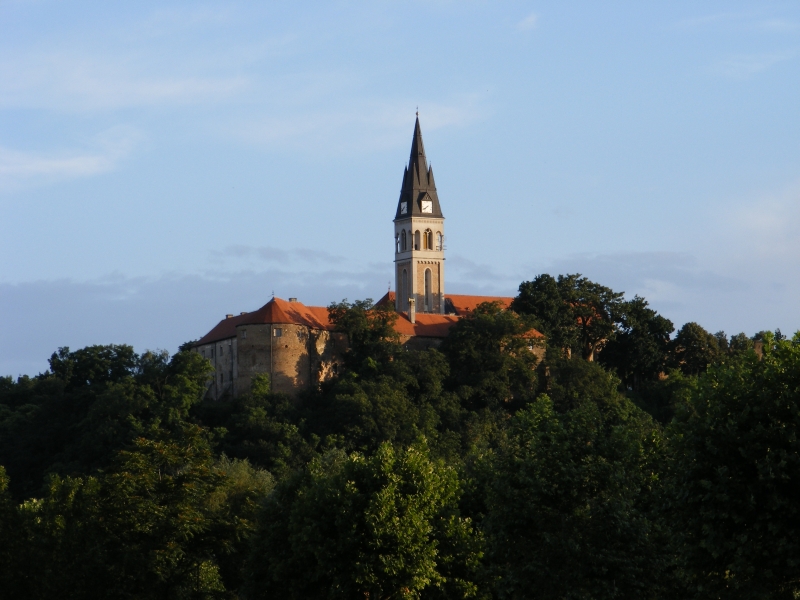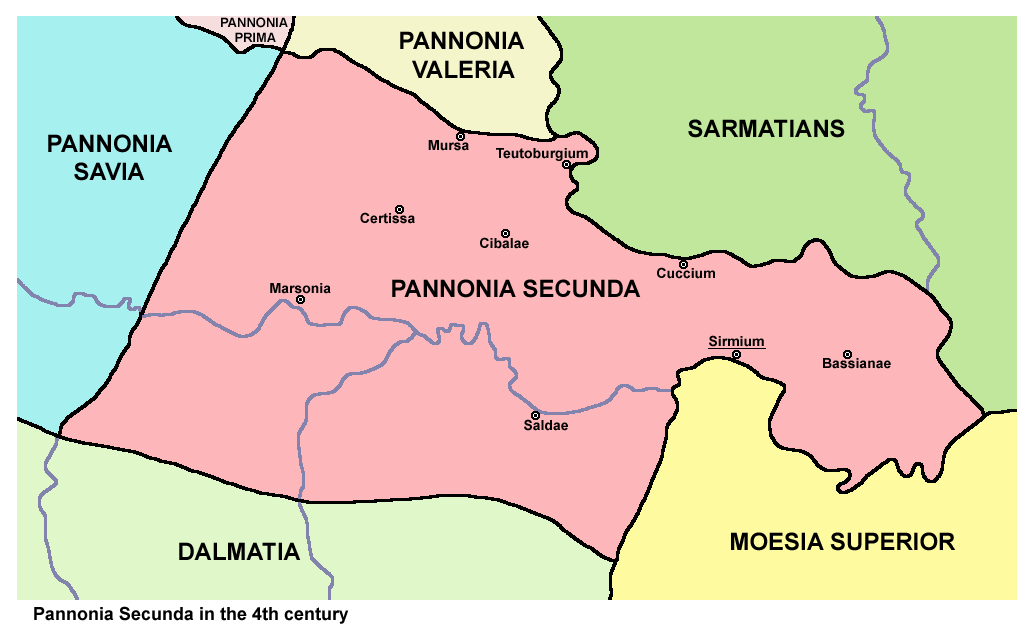|
Pannonia Secunda
Pannonia Secunda was one of the provinces of the Roman Empire. It was formed in the year 296, during the reign of emperor Diocletian. The capital of the province was Sirmium (today Sremska Mitrovica). Pannonia Secunda included parts of present-day Serbia, Croatia, and Bosnia and Herzegovina. History Before the creation of this province, its territory was part of the province of Pannonia Inferior. In the year 296, Pannonia Inferior was divided into two provinces - Pannonia Secunda in the south and Pannonia Valeria in the north. The border between the two newly established provinces was the River Drava. The capital of Pannonia Secunda, Sirmium, was also one of the four capitals of the Roman Empire; several Roman emperors were born in or near this city. In the year 314, there was a battle between two pretenders to the imperial throne, Constantine the Great and Licinius. The battle occurred in Pannonia Secunda, near the town of Cibalae. Constantine had an army of 20,000 men, while ... [...More Info...] [...Related Items...] OR: [Wikipedia] [Google] [Baidu] |
Province
A province is almost always an administrative division within a country or sovereign state, state. The term derives from the ancient Roman ''Roman province, provincia'', which was the major territorial and administrative unit of the Roman Empire, Roman Empire's territorial possessions outside Roman Italy, Italy. The term ''province'' has since been adopted by many countries. In some countries with no actual provinces, "the provinces" is a metaphorical term meaning "outside the capital city". While some provinces were produced artificially by Colonialism, colonial powers, others were formed around local groups with their own ethnic identities. Many have their own powers independent of central or Federation, federal authority, especially Provinces of Canada, in Canada and Pakistan. In other countries, like Provinces of China, China or Administrative divisions of France, France, provinces are the creation of central government, with very little autonomy. Etymology The English langu ... [...More Info...] [...Related Items...] OR: [Wikipedia] [Google] [Baidu] |
Ostrogoths
The Ostrogoths ( la, Ostrogothi, Austrogothi) were a Roman-era Germanic peoples, Germanic people. In the 5th century, they followed the Visigoths in creating one of the two great Goths, Gothic kingdoms within the Roman Empire, based upon the large Gothic populations who had settled in the Balkans in the 4th century, having crossed the Lower Danube. While the Visigoths had formed under the leadership of Alaric I, the new Ostrogothic political entity which came to rule Italy was formed in the Balkans under the influence of the Amal dynasty, the family of Theodoric the Great. After the death of Attila and collapse of the Hunnic empire represented by the Battle of Nedao in 453, the Amal family began to form their kingdom in Pannonia. Byzantine Empire, Byzantine Zeno (emperor), Emperor Zeno played these Pannonian Goths off against the Thracian Goths, but instead the two groups united after the death of the Thracian leader Theoderic Strabo and his son Recitach. Zeno then backed Theodori ... [...More Info...] [...Related Items...] OR: [Wikipedia] [Google] [Baidu] |
Posavski Podgajci
Posavski Podgajci is a village in eastern Croatia located west of Drenovci, near the border with Bosnia and Herzegovina. The population is 1,255 (census 2011). Name The name of the village in Croatian is plural. See also *Vukovar-Syrmia County *Cvelferija Cvelferija is a geographic region the Croatian part of Syrmia, in eastern Croatia. Villages in the region are Vrbanja, Croatia, Vrbanja, Soljani, Strošinci, Drenovci, Đurići, Račinovci, Gunja, Croatia, Gunja, Rajevo Selo, Posavski Podgajci. T ... References Populated places in Vukovar-Syrmia County Populated places in Syrmia {{VukovarSyrmia-geo-stub ... [...More Info...] [...Related Items...] OR: [Wikipedia] [Google] [Baidu] |
Ilok
Ilok () is the easternmost town in Croatia forming a geographic salient surrounded by Vojvodina. Located in the Syrmia region, it lies on a hill overlooking the Danube river, which forms the border with the Bačka region of Serbia. The population of the settlement of Ilok is 5,072, while the total town population is 3,407 (census 2021). The town is home to a Franciscan monastery and Ilok Castle, which is a popular day trip for domestic tourists. Name In Croatian, the town is known as ''Ilok'', in German as ''Illok'', in Hungarian as ''Újlak'', in Serbian Cyrillic as Илок and in Turkish as ''Uyluk''. In Hungarian language "Újlak" means "new dwelling or lodge". History The area of present-day Ilok was populated since the neolithic and Bronze Ages. One Scordisci archaeological site dating back to late La Tène culture was excavated in the 1970s and 1980s as a part of rescue excavations in eastern Croatia. The Romans settled there in the 1st or 2nd century and built Cuc ... [...More Info...] [...Related Items...] OR: [Wikipedia] [Google] [Baidu] |
Donji Petrovci
Donji Petrovci (Serbian Cyrillic: Доњи Петровци) is a village in Serbia. It is situated in Ruma municipality, Srem District, Vojvodina province. The village has a Serb ethnic majority and a population of 991 people (2002 census). There is a significant ancient Roman archaeological site near the village - the remains of large city Bassianae, which in the 3rd century had the highest status of '' colonia''. Name In Serbian the village is known as ''Donji Petrovci'' (Доњи Петровци) or sometimes simply ''Petrovci'' (Петровци); in Croatian as ''Donji Petrovci''; and in Hungarian as ''Petrovcze''. The name of the town in Serbian is plural. History In ancient times, an important Roman town known as Bassianae existed at this location. Today only small amount of this ancient settlement have been preserved. Bassianae was founded as an autonomous ''civitas'' in the 1st century and existed until the 6th century. It obtained the ''municipium'' status in 12 ... [...More Info...] [...Related Items...] OR: [Wikipedia] [Google] [Baidu] |
Bassianae
Bassianae or Bassiana ( Serbian: ''Basijana'' or Басијана) was an important ancient Roman town in Pannonia (today Syrmia region in Vojvodina province, Serbia). It was located near present-day Donji Petrovci, a village in the Ruma municipality. Bassianae was the second largest town in Syrmia, after Sirmium. It was located on a road that connected Sirmium and Singidunum. History Bassianae was founded as an autonomous ''civitas'' in the 1st century and existed until the 6th century. It obtained the ''municipium'' status in 124 AD, while in 214 AD it was recorded as a colony. Initially, the town was part of Pannonia province, but due to the subsequent divisions of this province, Bassianae was included into Pannonia Inferior (2nd century) and later into Pannonia Secunda (3rd century). It was one of the more important towns in the Pannonia province. During late Roman Empire, the town was a seat of one high official - ''procurator gynaecii Bassianensis Pannoniae secundae''. In the ... [...More Info...] [...Related Items...] OR: [Wikipedia] [Google] [Baidu] |
Vinkovci
Vinkovci () is a city in Slavonia, in the Vukovar-Syrmia County in eastern Croatia. The city's registered population was 28,247 in the 2021 census, the total population of the city was 31,057, making it the largest town of the county. Surrounded by many large villages, it is a local transport hub, particularly because of its railways. Name The name comes from the Croatian given name Vinko, cognate to the name Vincent. It has been in use following a dedication of the oldest town church of Saint Elijah () to Saint Vincent the Deacon () in the Middle Ages. The name of the city in Croatian is plural. It was called in antiquity. There is no known Latin or Greek etymology for , so it is assumed to be inherited from an earlier time. ''Cibale'' is a toponym derived from geomorphology, from Indo-European meaning "ascension" or "head". It is assumed that the root is in Proto-Indo-European (head), in the sense of a hill, meaning a place that was protected from the flooding of Bosu ... [...More Info...] [...Related Items...] OR: [Wikipedia] [Google] [Baidu] |
Slavonski Brod
Slavonski Brod (), commonly shortened to simply Brod, is a city in eastern Croatia, near the border with Bosnia and Herzegovina. Being one of the principal cities in the historical regions of Slavonia and Posavina, Slavonski Brod was the 7th largest city in the country, with a population of 59,141 at the 2011 census. It is the centre of Brod-Posavina County and a major river port on the Sava river. Names Although ''brod'' means 'ship' in modern Croatian language, Croatian, the city's name bears witness to an older meaning - 'water crossing', 'Ford (crossing), ford'. Among the names historically in use: ''Marsonia'' in the Roman Empire, ''Brood'' (in Slawonien) in the German speaking Austrian period, ''Brod na Savi'' after 1934. The ancient name "Marsonia" probably comes from the Proto-Indo-European word *mory (marsh), and the same root is seen in the nearby toponyms such as "Mursa" and "Mariniana". Geography The city is located southeast of Zagreb and at an elevation of . It d ... [...More Info...] [...Related Items...] OR: [Wikipedia] [Google] [Baidu] |
Đakovo
Đakovo (; hu, Diakovár) is a town in the region of Slavonia, Croatia. Đakovo is the centre of the fertile and rich Đakovo region ( hr, Đakovština ). Etymology The etymology of the name is the gr, διάκος (diákos) in Slavic form đak (pupil). The Hungarian ''diák'' word has the same Greek origin and as such it's uncertain whether the name came directly from Greek or via Hungarian or local Slavic form. History In Roman antiquity the settlement ''Certissia'' stood on the same spot until it disappeared during the Migration Period. The settlement's first mention in historical documents dates from 1239 when Béla IV of Hungary granted it to the Diocese of Bosnia ( la, Dioecesis Bosniensis), and the Bishop moved his seat here in 1246. The predecessor to the newer St. Peter's Cathedral was built in 1355. In 1374 the settlement is documented under the name ''Dyacou''. Croatian rebels in 1386 on 25 July captured Queen Mary of Hungary and her mother Elizabeth near the sett ... [...More Info...] [...Related Items...] OR: [Wikipedia] [Google] [Baidu] |
Osijek
Osijek () is the fourth-largest city in Croatia, with a population of 96,848 in 2021. It is the largest city and the economic and cultural centre of the eastern Croatian region of Slavonia, as well as the administrative centre of Osijek-Baranja County. Osijek is located on the right bank of the Drava River, upstream of its confluence with the Danube, at an elevation of . Name The name was given to the city due to its position on elevated ground, which prevented the city being flooded by the local swamp waters. Its name "Osijek" derives from the Croatian word ''oseka'', which means "ebb tide". Due to its history within the Habsburg monarchy and briefly in the Ottoman Empire, as well as the presence of German, Hungarian, and Serbian minorities throughout its history, Osijek has (or had) its names in other languages, Осек/Osek or Осијек/Osijek in Serbian, Hungarian: ''Eszék'', german: link=no, Esseg or Essegg, tr, Ösek, la, Essek. It is also spelled ''Esgek''. Its ... [...More Info...] [...Related Items...] OR: [Wikipedia] [Google] [Baidu] |
Byzantine Empire
The Byzantine Empire, also referred to as the Eastern Roman Empire or Byzantium, was the continuation of the Roman Empire primarily in its eastern provinces during Late Antiquity and the Middle Ages, when its capital city was Constantinople. It survived the fragmentation and fall of the Western Roman Empire in the 5th century AD and continued to exist for an additional thousand years until the fall of Constantinople to the Ottoman Empire in 1453. During most of its existence, the empire remained the most powerful economic, cultural, and military force in Europe. The terms "Byzantine Empire" and "Eastern Roman Empire" were coined after the end of the realm; its citizens continued to refer to their empire as the Roman Empire, and to themselves as Romans—a term which Greeks continued to use for themselves into Ottoman times. Although the Roman state continued and its traditions were maintained, modern historians prefer to differentiate the Byzantine Empire from Ancient Rome ... [...More Info...] [...Related Items...] OR: [Wikipedia] [Google] [Baidu] |






